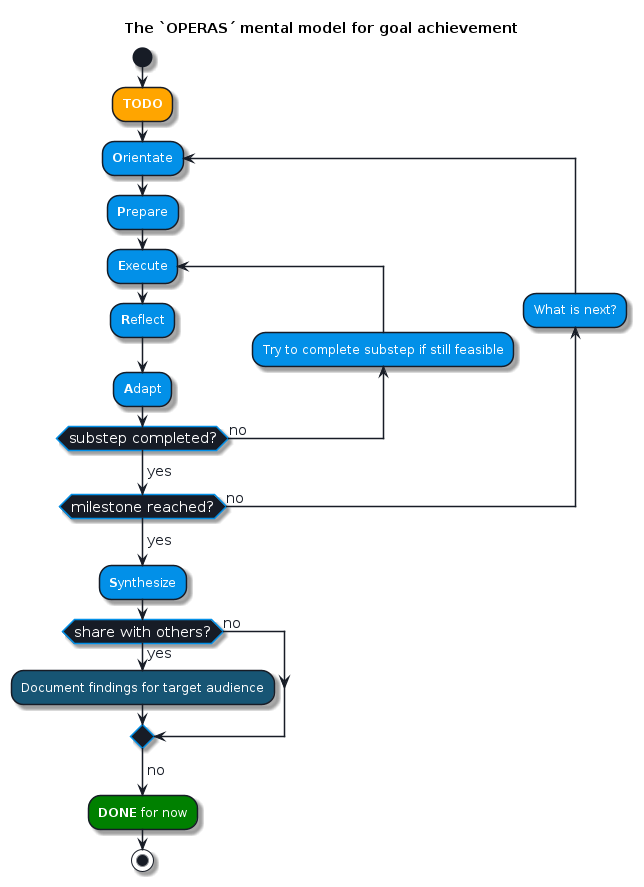The OPERAs method
Meta Info

Problem
How do you make structured progress towards a specific overarching goal?
Intent
- Your operational process is more structured
- You can apply different approaches to each step of the process
- You can keep tabs on the status of various goals and objectives, using the step names as status indicators
Contextual forces
What is this? These describe factors at play that influence the outcome of the practice. They are not necessarily good or bad, but they are important to be aware of. Some contextual forces are enablers, giving the practice a higher chance of being useful. Others are deterrents, making the practice less useful in your given context.
- You have a need to keep tabs on the status of various goals and objectives, by using the step names as status indicators
- having a clear idea of progress made, when combined with the KPI pattern
- split big goals into bite-sized chunks
- stay committed to your goals without feeling like you are drowning in a never ending cycle of irrelevant ‘side quests
Solution
Apply a consistent process to your problem-solving and goal achievements. The OPERAS mental model is a description of the flow you go through when advancing a task from “TODO” status to “DONE”. A task can be of any size, and can range from ‘build a house’ to ‘do the dishes’.

- define a goal you wish to work towards
- It is best to describe this goal in a measurable way, so tracking progress is easier in the future
- when working towards a goal, starting from a ’to do’ state, you perform a series of steps in order
- for some processes, a few of these steps could require very minimal effort.
- the acronym ‘OPERAS’ stands for the main steps in this model’s flow:
- Orientate
- Prepare
- Execute
- Reflect
- Adapt
- Synthesize
1. Orientate
Just like when finding your way through unknown territory, it is best to take in the landscape and plot your next sensible move forward. The idea is to think about the goal you wish to reach and figure out if there are any smaller milestones to reach in order to work towards your goal. An example: if you were to want to have a clean house, you could divide this into the cleaning of each room, doing the dishes, and taking care of the garden. Each of these sub-goals is a milestone to be reached in order to get towards your desired outcome.
2. Prepare
The preparation step is where you gather the tools needed to perform the action. These can either be physical assets, pieces of knowledge, or people whose assistance you need to enlist. This step is the transition between the more strategical aspects of your process to the practical execution of one of the milestones. Ask yourself: “What do I need to get the started?”, and then gather the resources needed to go ahead.
warning: The most common risk in this phase of the process is to over-analyse the situation. This antipattern is known as analysis paralysis and is extremely detrimental to making progress. Be sure you only identify the minimal set of required resources you need to START progressing. You can always loop back, and search for additional resources when they are needed.
Example: You wish to do the dishes, so you check that the dishwasher is not obviously broken. Then you go around the house and gather all the dirty utensils and plates you can find. The preparation step ends with a pile of dirty dishes on your kitchen counter.
3. Execute
You set out and do the task you intended to do. This is the operational phase of the process. You work on completion of the next sensible step to reach your first milestone.
Example: You load the dirty plates and cups into the dishwasher.
4. Reflect
At this point, you have finished working on one of the sub-tasks you set out to complete. Either the result was satisfactory or it was not. Either way, there are likely things that went well, and things that did not go well. Use these experiences as a learning mechanic to improve the way you approach tasks in the future. This is also an excellent time to revisit the original outline of the task distribution to see how to proceed.
Example: You were not able to do all the dishes as they would not all fit into the dishwasher. You also realized 40% of the time you spent on doing the dishes was used to collect the dirty plates and cups from all around the house.
5. Adapt
After reflecting on the actions taken and their outcomes, you can choose to adapt your approach using the insights you have gathered. This can either mean changing your approach entirely, or making small adjustments to the operational execution of your task. Example: You could wash some of your dishes by hand, as it will not take significant time to do so. Waiting for the dishwasher to complete before loading the next batch of dishes would just move the problem to the future.
Insepct! Is the sub-goal completed? If not, is it still useful to complete it? If it is: proceed to the next action that works towards its completion. If not: do something else.
6. Synthesize
After a milestone is reached, you can choose to synthesize the lessons you learned from this process. You could write down some key insights for future reference. In a social context, you might even share your insights with others, so they can learn from your experience.
Note that indirect learning is not for everyone, and others might repeat some of the mistakes you made. Even so, armed with your story, they might know a few coping strategies to resolve the situation if it takes a turn for the worst.
Further Exploration
- A. Hunt, The GROWS method, growsmethod.com.
- M. Barnes, The dream game, theeducationgame.com.